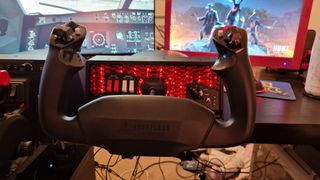12DOVE Verdict
Honeycomb's ultra-realistic flight controls are a fitting accoutrement to the depth that the flight sim genre can offer. They have all the bells and whistles to take your piloting to the next level, but unfortunately, that makes them very difficult to use if you're not planning on passing a few exams first.
Pros
- +
Highly realistic feel
- +
Premium build quality
- +
Super versatile for all sorts of aircraft simulations
Cons
- -
Intimidating for beginners
- -
Take up a little too much space
- -
Mounting plates could be better
Why you can trust 12DOVE
Honeycomb Aeronautical's latest set of hyper-realistic flight sim controllers are up there with the most detailed and believable you'll find. Both the Alpha XPC Flight Controls (a yoke and Switch Panel) and the Bravo Throttle Quadrant feel extremely lifelike, and they're some of the best PC controllers on the market for emulating the cockpit of a plane. While this makes them easy to recommend to any flight sim enthusiast, it makes them tough to put forward for someone who isn't planning on revolving their entire gaming setup around them.
As someone who's only casually played flight sim games since I was a kid, I was immediately intimidated by the scale, and uncompromising range of the Alpha and Bravo units. Just while unboxing and installing them, I felt like Frank Abagnale in Catch Me if You Can when he first gets asked "are you my deadhead?"
I can comfortably say that no video game controller has ever given me a stronger sense of imposter syndrome, and that's both a compliment and a criticism depending on your experience with flight sims. The Alpha XPC costs $349.99, and is compatible with PC, Mac, and Xbox Series X/S. The Bravo, meanwhile, will set you back $279.99, and is only compatible with PC and Mac if you don't pair it with the Alpha XPC. It's worth noting that while this is expensive, it's still around 70 bucks cheaper than something like the Thrustmaster TCA Yoke Pack.
Unfortunately, even once I'd familiarized myself with the functionality on offer with Honeycomb's latest, I still found that they had some flaws.
Design and Features
The Honeycomb Alpha XPC takes the brand's original yoke controller and makes it compatible with Xbox Series X and S. It features a full 180 degree yoke rotation with some fancy hall effect sensors that help to provide accurate and smooth functionality. On the yoke and switch panel, you get all the bells and whistles a pilot would need - a five-way, spring loaded ignition switch, a switch panel with 9 switches, an eight-way hat switch, two vertical two-way rocker switches, and even a button for push to talk. All of that is built into a premium-feeling, matte finished, and rubberized controller base.

Also in the box, you'll get the Honeycomb Xbox Hub which allows you to connect to your console with ease. You also get two locking clamps and a mounting plate for fixing the yoke down to your desk. More on those later.
The Alpha XPC connects via USB-C, and comes with a cable included. You also get an ethernet cable for connecting the yoke to the switch panel. Giving the whole module a really nice look is an embedded LED panel that exudes a classy red color.

As for the Bravo Throttle Quadrant, which is billed as an "all-in-one cockpit system", you'll find it's just as all-encompassing. It has six commercial levers with flaps, functional thrust reversers, and spoilers. It has another six general aviation levers with Go Around, and these can take on multiple configurations. It has a flap lever, autopilot buttons, an annunciator panel with seven different programmable switches, 14 (sweat-inducing) warning lights, a trim wheel, gear lever, partridge in a pair tree, and adjustable lever tension.

The design of each button, switch, and lever on the Bravo is as premium as you'd expect from the price, although if all of these buttons at all sound like overkill you might understand why they intimidated me.
Performance
If you're a flight sim nut, Honeycomb's Alpha XPC and Bravo are up there with the most detailed accessories you can get. Flight sims, especially contemporary ones, can tap into so much depth when it comes to piloting, and out of all the joysticks, yokes, and throttle quadrants I've tried, Honeycomb's controllers are some of the most lifelike I've found.

The yoke has such a premium feel to it. That matted, rubberized finish and 180-degree turning action really do heighten the experience. The throttles of the Bravo arguably feel even better, especially since you can swap out the heads of each lever to emulate whatever plane you're simulating. There isn't a switch, lever, panel, or button on the Alpha and Bravo that feels like it hasn't been ripped straight out of a decommissioned aircraft - and even without force feedback found in the best racing wheels, the resistance of the yoke in particular gives your arms a bit of a work out at times. Forcing a hulking great 747 down toward the runway in gale-force winds takes some doing, and the yoke having weight to its pulls and pushes really drives home that experience.
Unfortunately, this is where both the Alpha XPC and Bravo both start to slip up slightly. That resistance on the yoke in particular, and the lighter weight of the throttle board, means both controllers need to be securely locked to a desk or tabletop in order to function without sliding around. This isn't such a shock for enthusiasts - loads of folks revolve their entire gaming setup around a flight sim loadout, making controllers such as these a mainstay on their desks. The Alpha XPC, however, is also compatible with Xbox, and so it's a bit of a shame that there's just no way of using it on a couch, or integrating it into any setup that doesn't include one of the best gaming desks.

Arguably, even folks with desks might struggle. I have an IKEA desk with a lot more depth than your typical gaming desk. Even then, I struggled to fit the Alpha and Bravo controls on without seriously disrupting the layout of my monitors, or even having space for them both in the first place. The Alpha and Bravo aren't small pieces of hardware, so I can definitely see shallower desks struggling to accommodate them, even if monitor arms are in play. Moreover, fitting them both width-wise swallows up an awful lot of acreage. This is absolutely something you need to consider before you buy.

The other problem is that the mounting plates - the things that secure the Alpha and Bravo controllers down to your desk of choice, aren't the most trustworthy either. The two supplied clamps are akin to those found on mic arms you'd attach to a desk. These are fine, but they don't cater to thicker desks. Even with them unscrewed all the way, they barely manage to capture mine in their bite. Despite fastening these down securely, the flight controls themselves never really feel secure when I slot them into position. The mounting plates have suction pads and two rear turning screws on the back, all of which should lock the controllers into place. No matter how I try to fasten things down though, the yoke continually slips out of place, and almost off the mounting plate.
This is all adds up into a serious problem, because should the locking screws and mounting plates fail, it'll only take one hard push of the yoke to send the whole thing crashing through the best gaming monitor you own.

Should you buy the Honeycomb Flight Sim Controls?
If you're the kind of person whose religion is the flight sim genre, I can easily see the appeal of Honeycomb's Alpha and Bravo flight sim controls. They take the piloting experience to the next level of realism and depth that a lot of folks want. If you're looking for the nitty gritty detail of the most complex cockpits, and you're willing to study each plane's controls down to the finest switch, few flight sim controls will offer you the versatility and realism that these will.
Having said that, these aren't controllers for anyone who only wants to break out a joystick every now and again for a quick soar around their local airways. Even getting the controls installed and configured into X-Plane 12 made me feel like I should be supervised by a professional pilot.
A few design flaws also stop me from recommending these more enthusiastically. Namely, the depth of both controller modules compared to most desks, and the fitting mechanisms which have never inspired much confidence in me.
Honeycomb's Alpha XPC and Bravo flight sim controllers are geared at a very dedicated type of gamer; The ones who will be willing to adapt their entire setups to accommodate them, and the ones who want the closest thing to flying a real plane as money can buy. Perhaps more importantly, the type of person who looks at the admittedly steep price tag of both controller and shrugs it off as a must-have. For those types of people, Honeycomb's Alpha and Bravo will likely be ideal. For anyone else, there are a slew of best joysticks that would be cheaper, and easier to integrate into your setup.
How we tested the Honeycomb Flight Sim controls
I used the Honeycomb Alpha XPC and Bravo Throttle Quadrant extensively over a period of two to three weeks. I used the flight sim controls in X-Plane 12, and tested the various switches, throttle, and controller configurations in a slew of different in-game aircraft. To test the mounting plates, I secured both controllers down on my desk, as well as my dinner table to get a feel for how they fastened to different surfaces.
To read more about how we test the latest gaming tech, you can check out our Hardware Policy.
Fancy another Xbox compatible controller? Take a look at the best Xbox Series X controllers, the best Xbox Series X accessories, or the best Xbox One steering wheels.
One of my earliest memories is playing SuperMario64 and wondering why the controller I held had three grips, but I only had two hands. Ever since I've been in love with video games and their technology. After graduating from Edinburgh Napier University with a degree in Journalism, I contributed to the Scottish Games Network and completed an Editorial Internship at Expert Reviews. Over the last decade, I’ve been managing my own YouTube channel about my love of games too. These days, I'm one of the resident hardware nerds at 12DOVE, and I take the lead on our coverage of gaming PCs, VR, controllers, gaming chairs, and content creation gear. Now, I better stop myself here before I get talking about my favourite games like HUNT: Showdown, Dishonored, and Towerfall Ascension. Location: UK Remote














